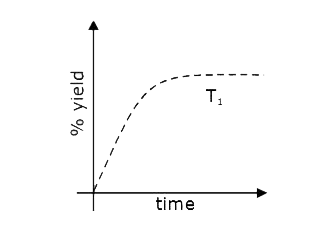Dinitrogen and dihydrogen react with each other to produce ammonia according to the following chemical equation:
N2(g)+3H2(g)→2NH3(g)
a. Calculate the mass of ammonia produced if 2.00×103g dinitrogen reacts with 1.00×103g of dihydrogen.
b. Will any of the two reactants remain unreacted?
c. If yes, which one and what would be its mass?
1 mol of N2, i.e., 28 g react with 3 mol of H2, i.e., 6 of H2. 2000 g of N2 will react with H2=628×2000g=428.6g.
Thus, N2 is the limiting reagent while H2 is the excess reagent. 2 mol of N2, i.e., 28 g of N2 produce NH3=2 mol = 34 g 2000 g of N2 will produce NH3=3428×2000g=2428.57g
(B) H2 will remain unreacted
(C ) Mass left unreacted = 1000 g – 428 .6 g = 571.4 g
Similar Questions
Dinitrogen and dihydrogen react with each other to produce ammonia according to the following chemical equation:
N2(g)+3H2(g)→2NH3(g)
a. Calculate the mass of ammonia produced if 2.00×103g dinitrogen reacts with 1.00×103g of dihydrogen.
b. Will any of the two reactants remain unreacted?
c. If yes, which one and what would be its mass?
View SolutionWhich of the following is correct for the reaction?
N2(g)+3H2(g)⇔2NH3(g)
View Solution
Knowledge Check
Which of the following is correct for the reaction? N2(g)+3H2(g)→2NH3(g)
AKP=KcBKP<KcCKP>KcDPressure is required to predict the correlationWhich of the following is correct for the reaction?
N2(g)+3H2(g)⇔2NH3(g)AKp=KcBKp<KcCKp>KcDPressure is required to predict the correlationWhich of the following is correct for the reaction?
N2(g)+3H2(g)⇔2NH3(g)AKp=KcBKp<KcCKp>KcDPressure is required to predict the correlation
For the chemical reaction
N2(g)+3H2(g)⇔2NH3(g)
The correct option is:
View SolutionFor the chemical reaction
N2(g)+3H2(g)⇔2NH3(g)
The correct option is:
View SolutionFor the chemical reaction
N2(g)+3H2(g)⇔2NH3(g)
The correct option is:
View SolutionThe % yield of ammonia as a function of time in the reaction N2(g)+3H2(g)⇔2NH3(g),(g)ΔH<0 at (P,T1) is given below

View SolutionWhich one of the following equation is correct forr the reaction : N2(g)+3H2(g)→2NH3(g) ?
View Solution
